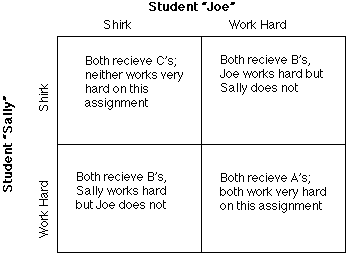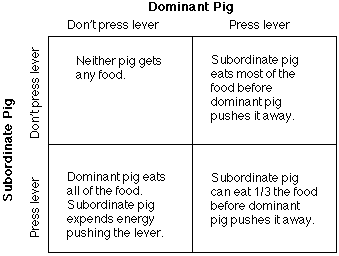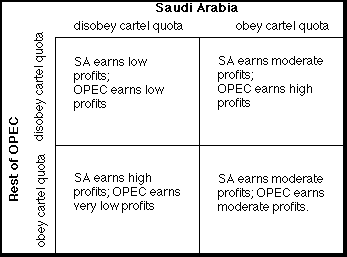Lecture Notes: Introduction to Game Theory
Copyright 1996, Froeb
Revised 7/19/96
Table of contents
- When players act optimally, rationally, and in their own self interest,
they reach a Nash Equilibrium.
- The Prisoners' Dilemma game illustrates the tension
between conflict and cooperation. The prisoner's dilemma can be applied
to
- How to escape from a prisoner's dilemma
- The Rational Pigs game illustrates "dominant"
strategies, and shows how weakness is sometimes an advantage. The rational
pigs game can be applied to competition between a large firm and a small
one, like that between Saudi Arabia vs. the Rest of OPEC
- The Location Game illustrates competition along a
geographic dimension. The location game can be applied to competition in
other dimensions, like program content. It is thought that such competiton
results in product bunching.
- The Dating Game sometimes called "battle of the
sexes" illustrates the problems of coordination. The dating game can
be applied to conflicts between division managers.
Nash Equilibrium
- The hallmark of strategic interaction is interdependent payoff functions,
i.e. my profits depend on what my rivals do. Game theory has made great
strides in characterizing the outcomes of strategic interaction. A game's
outcome is likely to be the Nash Equilibrium of the game.
- Nash equilibrium is an outcome (sometimes unique, sometimes not) in
which every player is acting optimally, rationally, and in their own self
interest. To check to see if a given outcome is a Nash Equilibrium, check
to see that no player can unilaterally do better by changing their strategy.
Prisoner's dilemma
- The most studied game in business is the prisoners' dilemma.
It illustrates a fundamental tension between conflict and cooperation.
Both prisoners would like to cooperate to minimize their sentences (lower
right corner below), but face a large temptation to turn in the other.
Consequently it is difficult to maintain such a cooperative agreement.
In the jargon of game theory, we say that such an outcome is not an equilibrium
of the game.
 Equilibrium is reached in the upper left corner: each competitor is
doing the best it can given what its opponent is doing. Neither competitor
can make unilaterally make himself better off. Note that this is not an
efficient outcome--the inefficiency is analogous to an
unconsummated wealth creating transaction.
Equilibrium is reached in the upper left corner: each competitor is
doing the best it can given what its opponent is doing. Neither competitor
can make unilaterally make himself better off. Note that this is not an
efficient outcome--the inefficiency is analogous to an
unconsummated wealth creating transaction.
Pricing dilemma
Advertising dilemma

- Discussion Question: How did the Tobacco companies
profits change follwing the government's ban of over-the-air cigarette
advertising?
Free Riding

- Assume that both students rank the outcomes as follows:
- A Grade of B and no work is better than
- A Grade of A and hard work which is better than
- A Grade of C and not working which is better than
- A Grade of B and hard work.
With this set of preferences, they reach a Nash equilibrium where each does
not work and both get C's even though they would jointly prefer A's and
working hard. Like all the prisoner's dilemma games, this illustrates the
fundamental conflict between competition and cooperation.
Discussion Question: Describe a prisoner's dilemma in
which either you or your company have been caught and tell me what you did
to get out of it.
How to escape from a prisoner's dilemma
The main message of the prisoners' dilemma is to not get caught in one.
Realize that being in a dilemma means that there are unconsummated wealth
creating transactions, and that getting out of a dilemma is analogous to
consummating them.
- Communicate, but this violates section 1 of the Sherman
Act. Often phone records are used in court as evidence that the firms were
communicating with one another. "Wire fraud" is much easier to
prove than price fixing.
- Alternatively, communicate indirectly:
- Price leadership. The Dept of Justice is investigating the tire manufacturers
in the US for anticompetitive pricing. Apparently Goodyear is the price
leader in the industry.
- Use "Focal Points". Example: $0.35 for candy bars; even 1/4
quotes on NASDAQ.
- Announce "Most Favored Customer" style agreements,
- Announce price increases.
- Commitment as a way out of a prisoner's dilemma:
Develop a reputation for "punishing" aggressive rival behavior,
i.e. following a rival's price cut, you price even lower. This is sometimes
referred to as commitment To analyze such games, look
ahead, and then reason back. A rival will look ahead and realize
that if he cuts price, it will provoke an aggresive response, i.e punishment.
If it believes it will be punished, it will not pursue such a course of
action.
The more severe the threatened punishment, the less likely rivals will
price low. However, the more severe the punishment, the less credible
it is. What if you actually have to use it? If firm 1 does price low, then
firm 2 would do better by not punishing firm 1, i.e. the threat is not credible.
Establishing credible threats is very difficult.
- In the bargaining section of the class, we will examine 8
ways to establish credibility.
- Best strategies for repeated prisoner's dilemma
games:
Economist Axelrod ran a tournament among economists to see which strategy
would win a repeated prisoners dilemma. He ran computer simulations to
determine the winner. Tit-for-Tat was the winning strategy. Axelrod identified
5 factors that characterized successful strategies:
- Be nice: no first strikes.
- Be forgiving: do not try to punish competitors too much.
- Be provocable: respond immediately to competitor aggressive moves.
- Don't be envious: focus only on your own slice of the profit pie, not
the size of your competitor's slice.
- Be clear: make sure your competitors can easily interpret your actions.
- How to avoid getting caught in a prisoner's
dilemma:
Change the structure of the game by making your product less sensitive
to rival's prices. Be creative. The goal here is to change the structure
of the game so that the mutually advantageous outcome is a Nash Equilibrium.
- Seek a competitive advantage: make your company less sensitive to the
pricing of rivals.
- Seek an unfilled niche; "Become a monopolist."
- Differentiate your product with design improvements, service, or advertising.
- Seek a cost advantage.
- Develop unique distribution channels.
The Rational Pigs
- This game illustrates that "strength" can be a strategic
weakness. In the payoff matrix below, calculate the Nash equilibrium. Note
that the weak pig has a dominant strategy, i.e. a strategy
that is best no matter what the strong pig does.

- Cartel Policing: Saudi Araba vs. rest of
OPEC
This game is an application of the rational pigs game to "obeying"
a cartel quota. In this case, Saudi Arabias relatively large oil reserves
and low production costs made it "stronger" than the rest of
OPEC, so that even when the rest of OPEC did not obey its cartel quota
(and produced too much), it was still in the Saudi's interest to keep to
its cartel quota given OPEC's dominant strategy of disobeying
its quotq. In other words, the rest of OPEC does better by disobeying,
no mater what the Saudi's do. The Saudi's best strategy still depends on
what the rest of OPEC does.

Discussion Question: Why would Saudi Arabia agree to
such a cartel?
The Location Game
This game illustrates competition in another dimension besides price.
In this case, two firms, A and B, charge identical prices, but choose where
to locate along a road in order to capture the biggest market share. The
dimension of competition is "location." This is a metaphor for
product "positioning."
Discussion Question: Is the following a Nash Equilibrium
of the Game?

Discussion Question: Is the following a Nash Equilibrium
of the Game?

Discussion Question: In which of the two graphs are
consumers better off?
Such product bunching was the original "justification"
for government supported programming. Although the original justification
has since disappeared with the spread of cable TV, proponents of continued
public funding have found new justifications. (editorial note: Most government
programs create interest groups that have an interest in maintaining the
programs. This makes its more difficult to get rid of programs than it is
to create them.--This is one of many unslanted opinions to which you will
be subjected during the course of the semester)
Discussion Question: Apply the product location model
to competition between political parties. How is the product bunching changed
by primary elections?
The Dating Game
This game illustrates the problems of coordinating activities--even when
activities are in the best joint interests of the parties.

In both the game above, and in the game below; The Nash equilibrium represents
an unrealized synergy. In the dating game, both enjoy each other's company;
and in the game below, the company would benefit from volume discounts if
both divisions used the same tire brand.

Discussion Question: Describe a "dating game"
in which you or your company has been caught. What did you do to get out
of it?